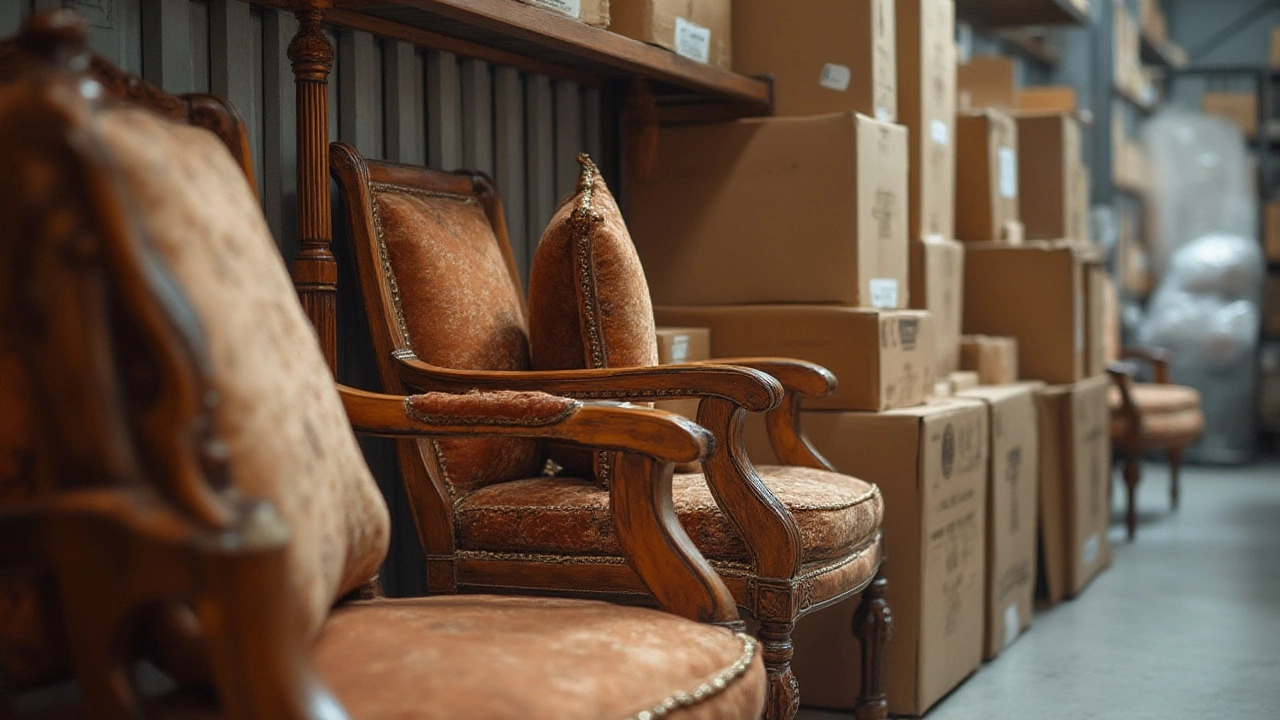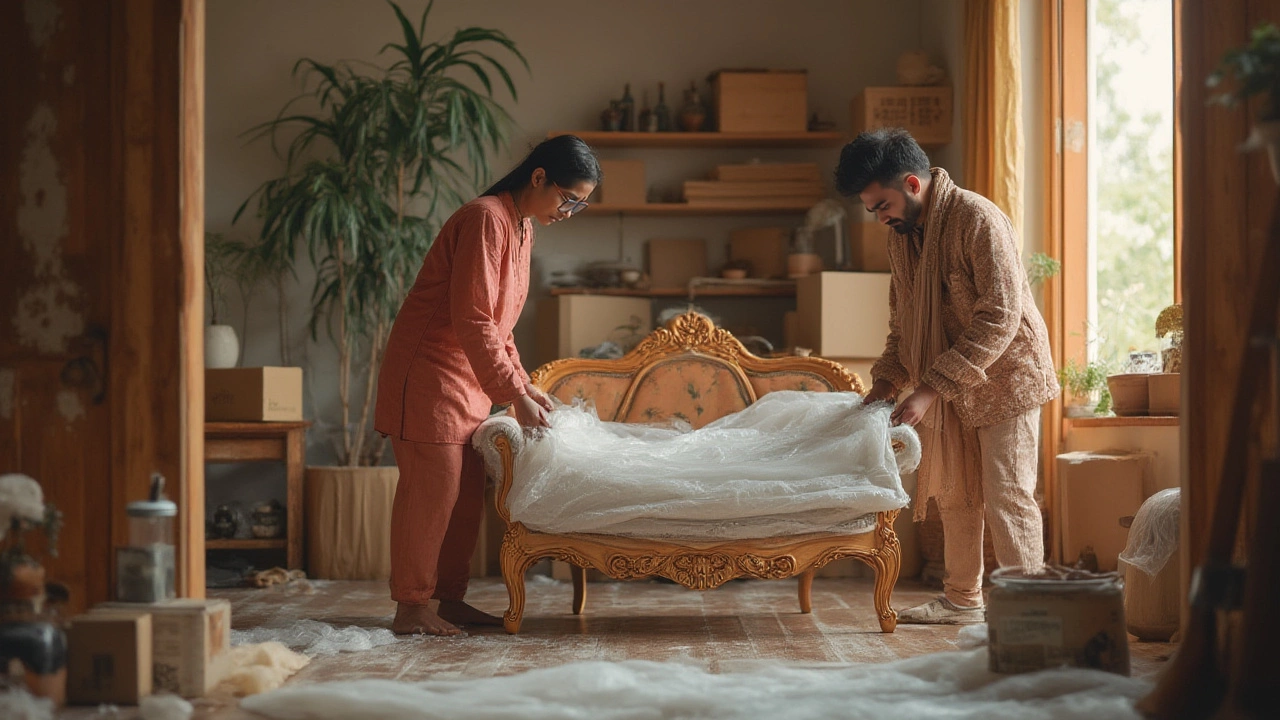Picture this: you haul your favorite sofa, that solid old oak chest, and a set of dining chairs into a storage unit. You lock up, walk away, and months later come back, dreading what you’ll find. Will your furniture survive? Some people swear their stuff came out looking brand new, while others tell horror stories about mold, warped wood, or smelly surprises.
The Real Threats: What Can Actually Ruin Furniture in Storage?
Let’s not sugarcoat it—furniture absolutely can get ruined in storage. The enemies aren’t mysterious. They’re stuff like humidity, temperature swings, pests, bad packing, and even the materials your furniture is made from. Some storage units morph into ovens in summer, then iceboxes in winter. Ever seen a warped bookshelf? That’s what wild temperature swings can do to wood. Leather sofas? Too much moisture and you’ll see mold, your cushions smelling like a wet dog. If your sofa sits on a concrete floor, moisture can creep up from underneath. Think your metal bed frame is safe? Rust can sneak in fast if air is damp enough.
Humidity is one of the nastiest culprits. If you’re storing furniture in a place with no climate control—just a basic garage or outdoor unit—expect real trouble. A study by the Furniture Industry Research Association (FIRA) found that wood absorbs and releases water depending on air moisture, causing swelling and shrinkage that crack joints and finishes. Mold spores? They love fabric sofas and mattresses. Just a few weeks in a damp, dark space can mess with the fibers, padding, and springs.
Then there’s sunlight. You’d think storage units are dark, but sometimes translucent roofs or badly sealed doors let in UV rays. That antique armchair can fade fast if light creeps inside every day, and the same goes for dyes in area rugs and curtains.
Pests have earned their reputation. Rats, mice, cockroaches, and even spiders can cause all sorts of chaos. Chewed upholstery, droppings, nesting in drawers—it happens. Some units spray for pests, but in older buildings or cheaper places, you can bet you’re not alone in there. And here’s a wild stat: one in seven self-storage renters report discovering pest damage to belongings after six months or more, according to a 2023 consumer survey from SpareFoot.
Improper packing is just the cherry on top of potential disaster. Stack a heavy box on an old chair? The legs warp. Don’t cover the couch? Dust gets everywhere. Wrap something in plastic? Sometimes that traps moisture, speeding up mold growth. Stack tall piles? Gravity does its work, especially if there’s a little shake or if the floor gets wet.
How Different Furniture Types Face Storage Hazards
Every furniture piece faces its own special risks in storage, depending on the material and design. Wood, like that beloved oak table or vintage dresser, suffers if the humidity isn’t steady. Expansion, contraction, and warping are common results. Veneered pieces might peel, while glue joints can loosen or even break apart. Even “hardwoods” are no match for months of bad conditions.
Upholstered items, including sofas and armchairs, hate moisture most of all. Mildew finds any hint of dampness in cushions, and fabric can go brittle in really dry climates. Ever opened a storage unit to find the musty, distinct stink of mold? That’s what happens when dust and moisture team up on cotton or wool. Sometimes, little black mold dots show up on the undersides where you can’t see them at first—yikes.
Leather, which many people think is indestructible, isn’t much better off. High temperatures can dry and crack surfaces, while humidity lets mold into the pores. Sunlight bleaches the finish, so even in a half-lit shed, leather can fade or discolor in just a season.
Metal furniture—like bed frames, filing cabinets, and shelves—faces the inevitable creep of rust when humidity is high. Even powder-coated finishes develop tiny scratches over time, letting water get in and start the rusting process. If you ever see brown dust at the base of a metal chair in storage, that’s rust at work, eating from the inside out.
Particleboard, the material in lots of today’s flat-pack furniture, probably fares the worst. If it gets wet, it swells, flakes, and loses strength. Don’t be surprised to find a once-sturdy shelf sagging or splitting. Like I heard from a friend who stored a bookshelf in a basement unit—one rainy season and it looked like oatmeal.
Glass pieces, such as coffee tables and cabinet doors, are less likely to warp or rot but they face a different problem: impact. Stack boxes too close, an accidental bump, and you’re left with shards instead of shelves.

How to Guard Your Furniture: Best Storage Tips from Real Pros
Okay, the dangers are real, but that doesn’t mean you’re doomed. It just means you need to plan for battle. Here’s what furniture pros and real-life storage warriors do to keep their stuff in prime shape:
- Choose climate-controlled storage whenever you can. Your furniture loves steady temperatures and moderate humidity, just like you. These units cost more, but they keep wood from swelling and sofas from turning into petri dishes. Aim for 55-80°F and under 60% humidity.
- Prep each piece: Clean first. Dust, food crumbs, and greasy spots are invitations for mold and critters. Let everything dry all the way before wrapping it up.
- Use the right covers. Skip plastic wrap on fabric or leather—it traps moisture. Go for breathable materials like cotton sheets or specially designed furniture covers. Wrap wood and metal with moving blankets for protection against dust and dings—not moisture.
- Disassemble big stuff. Remove table legs, take doors off cabinets, and wrap hardware separately. Less surface area means fewer risk spots for scratches or warping.
- Keep items off the floor. Use pallets or blocks to lift furniture, especially in outdoor or ground-level units.
- Don’t stack heavy boxes on delicate pieces. Store big, heavy stuff on the bottom, with lighter boxes up top. Never put boxes directly atop soft or fragile furniture.
- Leave breathing space. Air needs to circulate, so don’t jam everything together edge-to-edge. For mattresses and sofas, store them upright if you have to, but keep them off damp floors.
- Check for leaks before you sign anything. Water stains, musty smells, or bulging drywall are red flags.
- Add silica gel packs or moisture absorbers in and around furniture to pull up stray dampness.
- Treat for pests. Use traps or deterrents, especially if you’re in an older or country location.
And here’s a quick-reference table to match storage conditions with what’s best for most home furniture:
| Condition | Ideal Setting | Risk Level |
|---|---|---|
| Temperature | 55-80°F (13-27°C) | Low |
| Humidity | Under 60% | Low |
| Direct Sunlight | None | Low |
| Floor Contact | Wood Pallets/Blocks | Low |
| Cover Material | Breathable Cloth | Low |
Avoid cheap units unless you see the place in person. There’s no substitute for a quick inspection. If you spot cobwebs, unexplained dampness, or the kind of dust that says nobody’s been in for years, reconsider. Storing near a coast, or in humid climates? Go double on moisture control—think two layers of silica gel or invest in a small dehumidifier if allowed.
Packing tape, dryer sheets (for fresh scent and some pest deterrence), old blankets—they’re all cheap insurance. Write down what you pack and where. This isn’t just an organizing tip—it means you won’t dig through boxes, knocking over your own stuff, when you come to check or retrieve it.
Real Stories and What to Do If Things Go Wrong
So what happens if, despite all this, you open your storage unit and find that dreaded musty whiff? Maybe mold spots, chewed corners, or water stains? First, don’t panic. Sometimes, early-stage damage is fixable.
If you see mold, take the item out as fast as possible—open space is your friend. Small spots can usually be cleaned with mild detergent and water (for wood and most upholstery). For leather, try a vinegar-water mix, but always dry the area completely. If you see black mold or a strong smell, it could be deeper inside—time to call a specialist or, for low-value pieces, maybe say goodbye.
Water stains on wood can sometimes be buffed out gently with steel wool or treated with products like Old English. But if wood splits or curves, warping is harder to fix. The same goes for rust: minor surface rust can be rubbed with baking soda and a damp cloth, but deep rust means the item might be compromised structurally.
Insurance is worth a look. Most storage places offer it (for a fee), but always read the fine print. Some policies won’t cover water damage, pests, or mold—just fire or theft. Document everything when you put your furniture storage away: snap photos, note the condition, and log serial numbers. If you have to report a claim, this is gold.
And remember, the best recovery is prevention. Set reminders to visit your storage unit every couple of months, even if it’s just to peek in and take a sniff. The quicker you spot a problem, the cheaper and easier it is to handle. Especially if you’re storing sentimental pieces—a grandparent’s chair, a wedding gift, or just that perfectly broken-in reading recliner—you want peace of mind.
If, after all this, you’re on the fence about storage, consider alternatives like lending furniture to friends, rotating it into your own space, or hiring a company that specializes in long-term furniture preservation. The costs might be higher initially, but think of it as buying insurance for your favorite possessions—less stress, and much less heartbreak when it’s time to reclaim your stuff.
Bottom line, furniture isn’t doomed as soon as it hits storage—but it’s up to you to stack the odds in your favor. A bit of preparation, smart packing, and the right storage spot can make all the difference between treasured heirlooms and tragic losses.

